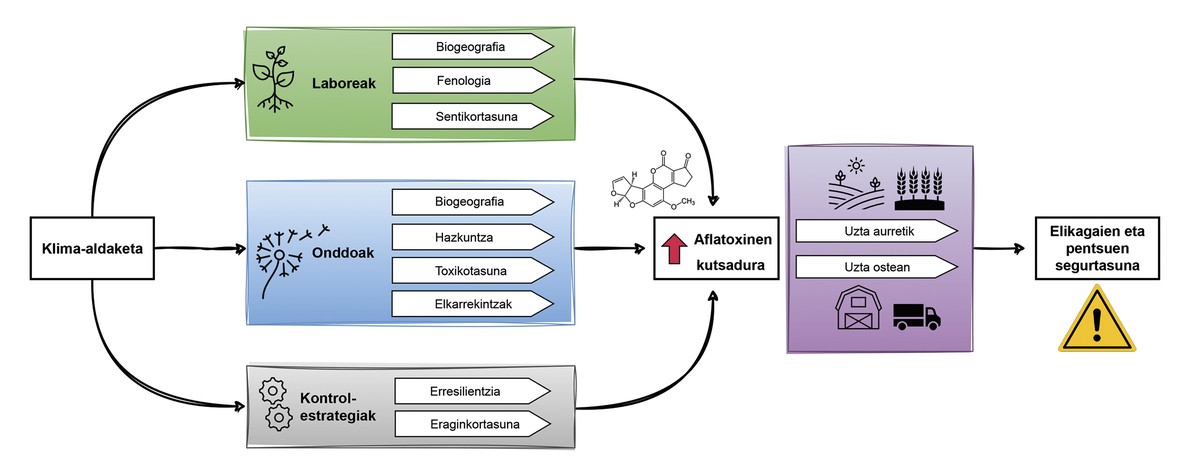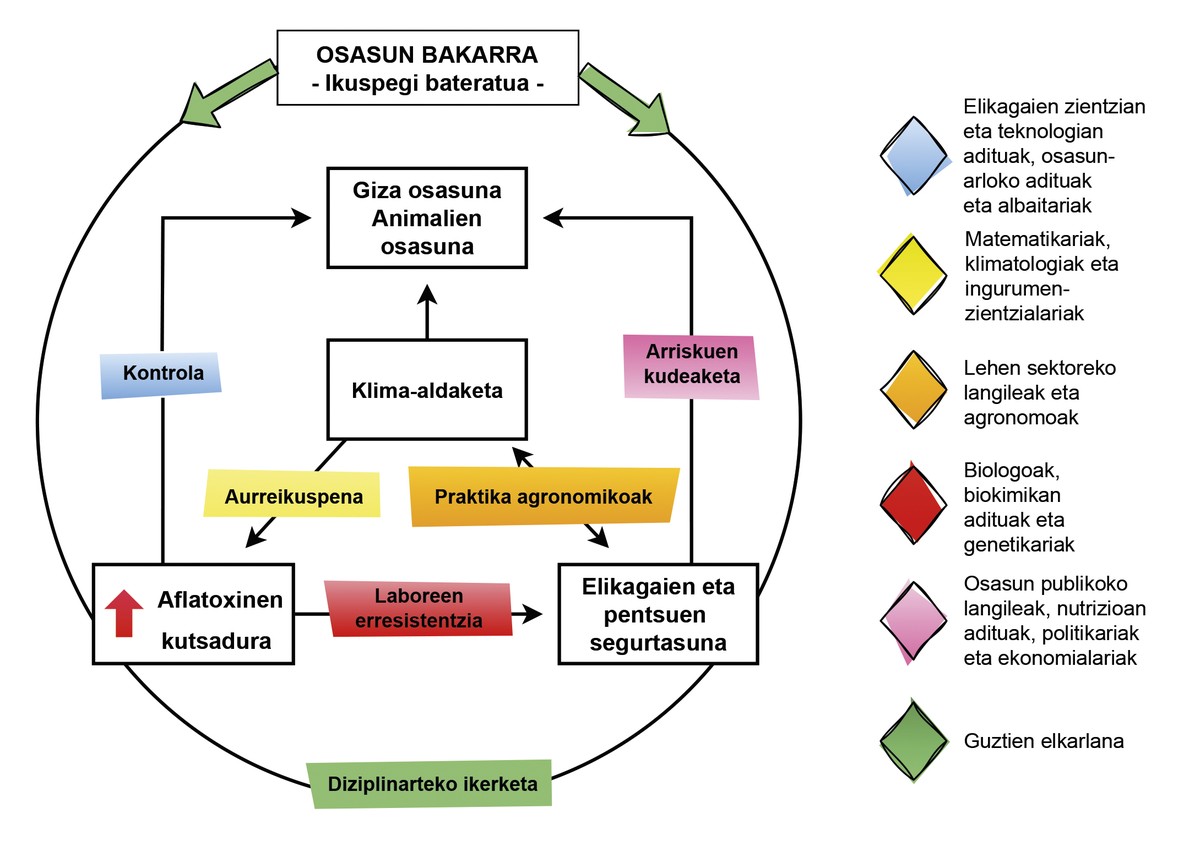Food and feed safety S.G.
In the 21st century, it's not
just man, more connected than ever.
Strategy for future risks
Single Health Approach.
Food and feed security problems, crops
threatened by climate change and fungi.
Environmental damage, livestock and health humana.La interdisciplinary research
is the essential key in the control, prevention and prediction
of these risks.
Let us ensure safe food in the future.
According to the Food and Agriculture Organization of the United Nations, about 25% of food worldwide is contaminated with mycotoxins [1]. Mycotoxins (from Greek: mykes, onddo; and from Latin: toxium, venom) are natural toxic contaminants produced by fungi. Despite years of research and good manufacturing and farming practices in the food and feed chain, contamination of these toxins seriously threatens food and feed safety. Low-income countries are the most vulnerable to pollution, despite global damage. On the one hand, mycotoxins affect human and animal health and the productivity of animals and crops. Moreover, the withdrawal from the market of contaminated products alters domestic and international trade and causes significant economic losses [2].
Certain groups of mycotoxins are given particular consideration in terms of food safety and regulation [3]. Among them, toxins produced by fungi of the genus Aspergillus (aflatoxins) are one of the most frequent and dangerous toxic mycotoxins. Consumption of aflatoxin-contaminated food and feed can have serious consequences for human and animal health, such as increased cancer risk, stunted growth and weakened body defenses. In addition, direct contact with aflatoxins can be fatal, usually causing serious liver damage and [4].

When, where and how are foods contaminated with aflatoxins?
Aflatoxins are a famous and annoying cause of food poisoning. Food and feed contamination can occur directly in rural areas. Contamination occurs mainly in the cultivation and harvesting process (called prenuptial contamination), but also in the storage, processing, transport or marketing of crops (known as post-harvest contamination) [5].
Invasion of aflatoxins can therefore occur throughout the food and feed production chain. In addition, aflatoxins attack all major crops, including world consumer cereals such as maize, rice, sorghum and wheat. They also affect nuts such as peanuts, pistachios, tree fruits, coffee and cotton seeds [6]. The contamination of maize is of particular concern for its role in the supply of food and feed worldwide. Dairy products are also not exempt from aflatoxin contamination. In fact, if animal feed is contaminated by aflatoxins, food from these animals may also be contaminated.
How does this all relate to climate change?
Climate change is one of the greatest threats to human health in the 21st century. Consequently, temperature increases, changes in precipitation patterns, accumulation of carbon dioxide in the atmosphere and intensification of extreme weather events such as droughts and floods are expected [7]. This changing environment has a great influence on the primary agricultural systems, as it affects both the environmental conditions of the field and the warehouses. Climate change is therefore currently one of the main concerns related to food and feed safety. As for aflatoxin contamination, climate change reinforces the contamination of these natural toxins in three ways.
On the one hand, environmental factors associated with climate change weaken crops. Stress conditions caused by extreme weather events and agronomic practices to combat them (e.g. increased use of pesticides) favour more pests and diseases, making crops more susceptible to aflatoxin contamination. In addition, climate variations produce significant changes in crop biogeography (i.e. geographical distribution) and phenology (i.e. flowering).
Moreover, climate change significantly affects the characteristics of aflatoxin-producing fungi, such as biogeography, growth, toxicity (i.e. the ability to produce aflatoxins) and interactions of fungi. Aflatoxin-producing fungi are widespread around the world, but they prefer warm, humid climates and drought situations. The warm, wet climate reinforces the growth of fungi, while droughts, as if they were awakening, enhance their activity in both toxicity and interactions. Until a few years ago, these conditions were limited to tropical and subtropical areas [8], but due to changing climatic conditions, the presence of aflatoxins in southern and eastern Europe has become common practice in recent decades [9].

Between 1990 and 1995, the Department of Health of the Basque Government, in a study, measured the amount of aflatoxin consumed in the diet of the population of the Basque Country. According to the study, dairy products never exceeded the limit set by the legislation. In contrast, in imported nuts, few samples of pistachios and peanuts exceeded the limits of the law.
Finally, climate change can reduce resilience (i.e. the ability to undergo change) and the effectiveness of control strategies currently used to control and/or reduce aflatoxin contamination. For example, environmental factors seem to reduce the disinfectant effect of fungicides (anti-fungal substances).
Who and how to address the problem in the future?
We've seen how the complex effects of climate change make controlling aflatoxins increasingly difficult around the world. The fundamental role of control strategies before and after harvest is undeniable. However, the need for continuous evaluation of current control measures to ensure the capacity to withstand changes in climate-related environmental factors has been highlighted. Given the difficulty of achieving full control, it would be helpful to anticipate the impact of climate change on aflatoxin contamination [11]. But it's not easy at all. Therefore, to avoid false or imprecise predictions, it is first necessary to better understand the processes of the real world.

In the meantime, sustainable agronomic practices are necessary to adapt to climate change in the short and long term and to ensure crop production and safety. The use of resistant crops could also be an effective strategy to reduce pollution [12]. Have genetically modified plants come to mind, right? There are other less sophisticated solutions. For example, maize appears to be more easily contaminated with aflatoxins than other smaller grain cereals. Therefore, diversifying the diet and putting on the table new, more resistant food crops naturally can be not only a new gastronomic experience, but also a strategy to reduce the food poisoning of aflatoxins.
It is clear that climate change affects the entire food and feed supply chain, and so all processes and partners involving food chains are involved. Therefore, the only ones responsible for this problem are not sectoral or sectoral experts. Moreover, the contribution of all is essential to formulate effective policies, update existing rules and laws and adequately manage risks at global and national level [13]. In this regard, the development of effective actions requires a common approach covering all sectors and disciplines involved in this complex problem. Interdisciplinary research is therefore essential for a more realistic analysis of possible situations and for the development of successful control, prevention and management strategies for food and feed safety.
In short, the vision of Single Health before this complex multidisciplinary problem is the only promising strategy, since only he believes that human, animal and environmental health are inseparable. This common approach, beyond policy management and agriculture, will lead to economic success and to the health guarantee of animals, humans and the environment. We therefore wish to conclude that it is essential to address the fight for food and feed safety from this common perspective.
Bibliography
- Park, D. L. Njapau, H., Boutrif, E. (1999). Minimizing risks posed by mycotoxins using the HACCP concept. Food, Nutrition and Agriculture, 23, 49–55. http://www.fao.org/docrep/X2100T/x2100t08.htm#TopOfPage
- European Commission (2022). RASFF - food and feed safety alerts. Available: https:// ec.europa.eu/food/safety/rasff_en. Consultation date: 16 February 2022.
- European Food Safety Authority, EFSA. (2013). International frameworks dealing with human risk assessment of combined exposure to multiple chemicals. EFSA Journal 11:3313.
- European Food Safety Authority, EFSA. (2004). Opinion of the Scientific Panel on Contaminants in the Food Chain (OTRASPanel) related to aflatoxin B1 as undesirable sustance in animal feed. EFSA Journal 2:39.
- Joint FAO/WHO Expert Committee on Food Additives, JECFA. (2017). Evaluation of certain contaminants in food. Food and Agriculture Organization of the United Nations, World Health Organization Technical Report Series 1002.
- [6]CAST. (2003). Council for agricultural science and technology - task force report.
- IPCC. (2021). Summary for Policymakers. Contribution of Working Group I to the Sixth Assessment Report of the Intergovernmental Panel on Climate Change. Cambridge University Press.
- Medina, A., Rodríguez, A., & Magan, N. (2014). Effect of climate change on Aspergillus flavus and aflatoxin B1 production. Frontiers in Microbiology, 5, 1–7. https://doi.org/10.3389/fmicb.2014.00348
- AESAN Scientific Committee. (2021). (Working Group) Marín, S., Daschner, A., Morales, F.J. Rubio, C., Ruiz, M.J. and Burdaspal, P. Report of the Scientific Committee of the Spanish Food Safety and Nutrition Agency (AESAN) on the effects of climate change on the presence of mycotoxins in food. AESAN 33, pp. 11-51.
- Bittor Rodriguez Rivera (2009). Food Toxicology. Editions Elhuyar, 1-209.
- Battilani, P., Toscano, P., Van Der Fels-Klerx, H. J. Moretti, A., Leggieri, M. C. Brera, C., Rortais, A., Goumperis, T., & Robinson, T. (2016). Aflatoxin B 1 contamination in maize in Europe increases due to climate change. Scientific Reports, 6, 1–7. https://doi.org/10.1038/srep24328
- Jallow, A., Xie, H., Tang, X, Qi, Z., & Li, P. (2021). Worldwide aflatoxin contamination of agricultural products and foods: From occurrence to control. Comprehensive Reviews in Food Science and Food Safety, 20(3), 2332–2381. https://doi.org/10.1111/1541-4337.12734
- Valencia-Quintana, R. Miliic, M., Jakšiic, D., Tiza, M. Š, Tenori-Arvide, M. G., Pérez-Flores, G. A. Bonassi, S., & Sánchez-Alarcón, J. (2020). Environment changes, aflatoxins, and health issues, a review. International Journal of Environmental Research and Public Health, 17(21), 1–10. https://doi.org/10.3390/ijerph17217850.
Buletina
Bidali zure helbide elektronikoa eta jaso asteroko buletina zure sarrera-ontzian











